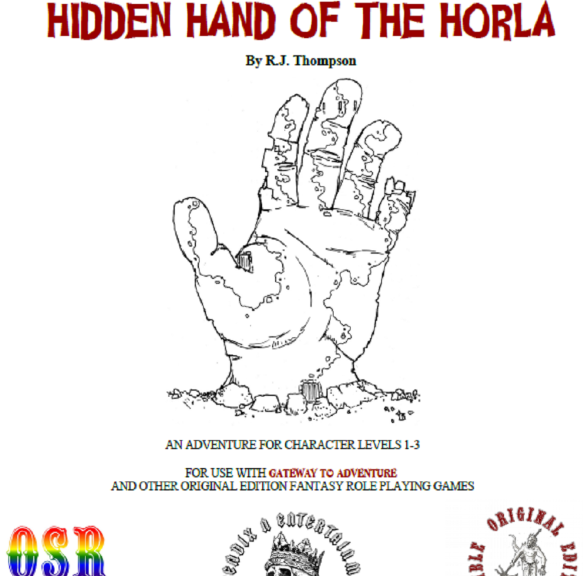+R. J. Thompson of Gamers & Grognards has launched a new company, Apendix N Entertainment, and its first product, T1 Hidden Hand of the Horla [Affiliate Link], is now on OBS as PWYW. You can find it at either DriveThruRPG or RPGNow [both Affiliate Links].
I received a pre-release copy, and within a couple of days of that I received the final copy. I spotted one typo in the pre-release copy that was corrected in the final release.
Hidden Hand of the Horla [Affiliate Link] is the beachhead product waiting for Ryan’s take on the original roleplaying game, Gateway To Adventure. The cover is familiar to many who follow +Dyson Logos’ maps, a giant hand that is a set of towers. Ryan uses this map to full effect in the few pages of this module for levels 1-3.
One paragraph briefly touching on the old school style of play, one paragraph of player background, and three paragraphs for the referee. There are tables that define certain conditions of the adventure so it will not be identical. For example, the intended foes in the module can find one of the items before the players and use it against them. There is a rumor table to help the GM determine a random rumor that each PC knows about the place. And a well planned random monster tables that indicates which potential creatures represent a creature from a specific room.
Only five pages are needed to describe this small dungeon, with stats for a few creatures in the text.
The either total creature types are listed in the three page bestiary. A new creature is introduced that will require players to use their wits to best it, or avoid having to best it. For those used to rolling dice or otherwise unaccustomed to the old school style of play, it has the potential for a TPK. Players that use their heads and are team players should do well.
There are two pages of spells. Two of them new spells. The Hand Tower was built by a wizard specializing in hand spells.
True to the name of the company, there is a one page Appendix N, that includes inspirational writing, film, television, and music.
Following the OGL is a page with the hand tower, a page with a player handout, and a page with the map of the interior.
What I Liked
This is a great to the point adventure. It is simple, but with enough to the point details to help the GM run this. As a low level adventure, it could easily be modified for those who like DCC and 0 level funnels, or be powered up to handle more players or fewer players of higher level. Best of all it is designed to be reused, so is ideal for an initial adventure that is a location that can serve as the first adventure in a new campaign. The goatmen that Ryan included from his home campaign are one hit die creatures so you could easily re-skin them for the main one hit die creatures in your own campaign, if you didn’t want to introduce goatmen. There are also simple ideas for modularity of design that are easy to adapt to on the fly adventures you may run in your own campaign, or that other publishers would like to see.
He also has an idea for books that I’m going to steal for use in a future update to my own PDF on Libraries.
What I’d Like To See
This is a challenge to find something that is missing. I liked it and could see myself running it, and would like to play it if I didn’t know the secrets. I read this a couple days ago and I’m still not finding anything that seems lacking. While it may seem trite, the only thing I can think of that I want is more modules like this. I look forward to the release of his take on the original RPG.
The only thing I see is that the OGL takes a bit more than a full page and goes onto the page with the hand image. A font small enough to get the OGL on one page is fine with me. this is very minor and can easily be trimmed off, or covered, if printed, but might detract from player experience if you show them the map from an electronic device. I only mention this as it is in the version now live on OBS as I write this.
Full Disclosure
Ryan and I are friends. We met at UCon a few years ago after I reviewed another publication of his. As a friend, I wish there was something that jumped out at me that needed work. I hope I didn’t gloss over anything that others will point out as problematic, or needing more polish.
Pay What You Want doesn’t do this module justice. You should at least pay something in the realm of a dollar or more for this.


